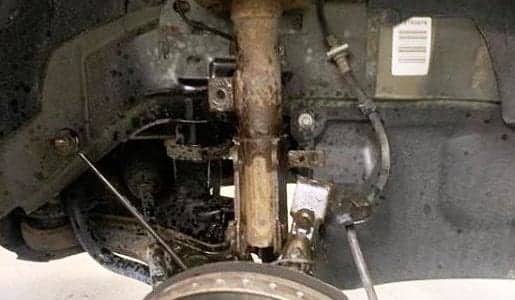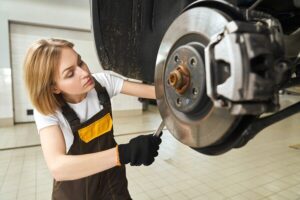
In the realm of automotive maintenance, there are certain components that often lurk in the shadows of attention, yet their significance to the overall performance and safety of a vehicle cannot be overstated. One such component is the strut. While it may not command the spotlight like engines or brakes, the strut plays a crucial role in ensuring a smooth and stable ride. From absorbing the bumps and jolts of the road to maintaining proper tire alignment, struts quietly go about their business, often unnoticed until they begin to falter. In this blog, we delve into the realm of strut replacement, shedding light on its importance, the signs indicating when it’s time for a change, and the steps involved in ensuring your journey remains as smooth as possible.
Understanding Struts: A Foundation for Smooth Travel
Struts, often overshadowed by more prominent components, serve as the silent guardians of your vehicle’s ride quality. Essentially, struts are part of the suspension system, tasked with dampening the impact of bumps and uneven road surfaces. By absorbing shocks and vibrations, they contribute significantly to stability and comfort while driving. Comprising a piston, hydraulic fluid, and a coil spring, struts work in unison to minimize the transfer of road imperfections to the vehicle’s body. Understanding their role is paramount for appreciating their impact on your driving experience, as well as for recognizing when they require attention or replacement.
Signs of Strut Trouble: Listening to Your Vehicle’s Cues
Despite their silent operation, struts often communicate their distress through subtle yet telling signs. One of the most common indicators of strut trouble is excessive bouncing or instability while driving, especially over uneven terrain. Additionally, you might notice increased body roll during cornering or a nose-dive sensation when braking firmly. Unusual noises, such as knocking or clunking sounds when going over bumps, could also signify deteriorating struts. Paying heed to these cues and promptly addressing any abnormalities can prevent further damage to your vehicle’s suspension system and ensure a safer, smoother ride for miles to come.
Importance of Prompt Replacement: Safeguarding Performance
Ensuring prompt replacement of worn-out or damaged struts is crucial for safeguarding the performance and safety of your vehicle. Ignoring signs of strut deterioration can lead to a host of issues that compromise your driving experience and put you at risk on the road. Here’s why timely strut replacement matters:
- Preserves Ride Comfort: Worn struts can result in excessive bouncing and instability, making your drive uncomfortable and potentially hazardous.
- Maintains Handling and Braking Efficiency: Damaged struts can affect your vehicle’s ability to handle corners and brake effectively, compromising overall safety.
- Prevents Accelerated Tire Wear: Failing struts can cause uneven tire wear, reducing tire lifespan and necessitating premature replacements.
- Ensures Road Stability: Properly functioning struts contribute to maintaining stability and control, especially on rough or uneven road surfaces.
- Prevents Costlier Repairs: Addressing strut issues promptly prevents further damage to other suspension components, avoiding potentially costly repairs down the line.
Prioritizing timely strut replacement not only preserves ride comfort and performance but also enhances overall driving safety while preventing unnecessary expenses. Don’t wait until it’s too late—schedule a strut inspection and replacement if needed to keep your vehicle running smoothly and safely on the road.
DIY vs. Professional Replacement: Weighing Your Options
When facing the need for strut replacement, vehicle owners often encounter the dilemma of whether to tackle the task themselves or enlist the expertise of professionals. While a DIY approach may appeal to the budget-conscious or mechanically inclined, it’s essential to weigh the risks and complexities involved. Strut replacement requires specialized tools, technical know-how, and precise alignment adjustments to ensure optimal performance and safety. Professional mechanics possess the experience and resources to execute the job efficiently and accurately, minimizing the likelihood of errors or future complications. Ultimately, the decision boils down to individual skill level, available resources, and willingness to invest in the longevity and reliability of your vehicle’s suspension system.
Choosing the Right Struts: Quality Matters for Longevity
Choosing the right struts is crucial for ensuring optimal performance and longevity of your vehicle’s suspension system. Quality matters, as subpar struts can lead to compromised ride comfort and safety hazards. Here’s how to make the right choice:
- Prioritize Compatibility: Ensure the struts are compatible with your vehicle’s make and model to guarantee proper fit and function.
- Consider OEM Options: Original Equipment Manufacturer (OEM) struts are designed to meet manufacturer specifications, providing seamless integration and reliable performance.
- Research Aftermarket Brands: Explore reputable aftermarket brands known for offering high-quality alternatives to OEM struts, often at a more affordable price point.
- Evaluate Durability: Look for struts constructed from durable materials capable of withstanding the rigors of daily driving and varying road conditions.
- Review User Feedback: Check user reviews and ratings to gauge the overall satisfaction and performance of different strut options, helping inform your decision-making process.
Selecting the right struts requires careful consideration of compatibility, quality, and durability. Whether opting for OEM or aftermarket options, prioritize reliability and performance to ensure a smooth and safe driving experience for miles to come.
Installation Process Demystified: Steps to a Seamless Swap
While the prospect of replacing struts may seem daunting to some, understanding the installation process can help alleviate anxiety and ensure a smoother transition. Begin by safely lifting and securing the vehicle, taking care to relieve tension from the suspension components. Next, remove the wheels and disconnect any necessary components, such as brake lines or sway bars, to access the struts. Utilize appropriate tools to loosen and remove the mounting bolts, then carefully extract the old struts from their position. Before installing the new struts, inspect accompanying components for wear or damage, replacing as needed. Finally, reverse the disassembly process, ensuring all components are securely fastened and aligned before lowering the vehicle to the ground. A methodical approach and attention to detail are essential for a successful strut replacement, and consulting a repair manual or seeking professional guidance can offer additional clarity and confidence throughout the process.
Maintaining Strut Health: Tips for Prolonging Performance
To ensure the longevity and optimal performance of your vehicle’s struts, proactive maintenance is key. By following these simple tips, you can prolong the lifespan of your struts and preserve the smoothness and stability of your ride:
- Regular Inspection: Routinely inspect your vehicle’s suspension components for signs of wear, leaks, or damage.
- Maintain Proper Tire Inflation: Ensure that your tires are inflated to the manufacturer’s recommended pressure to reduce strain on the struts.
- Wheel Alignment: Keep your wheels properly aligned to prevent uneven tire wear and reduce stress on the suspension system.
- Avoid Rough Terrain: Minimize exposure to rough roads and potholes, as they can accelerate wear and tear on the struts.
- Address Abnormalities Promptly: If you notice any unusual noises or sensations while driving, such as knocking sounds or excessive bouncing, have your vehicle inspected by a professional.
Proactive maintenance practices such as regular inspections, proper tire inflation, wheel alignment, and avoiding rough terrain can help prolong the performance and lifespan of your vehicle’s struts. By addressing any abnormalities promptly and seeking professional assistance when needed, you can ensure a smooth and stable ride for miles to come.
Conclusion
Understanding the vital role of struts in ensuring a smooth and safe ride is essential for every vehicle owner. By recognizing the signs of strut trouble and prioritizing prompt replacement, you not only safeguard your vehicle’s performance but also enhance driving safety for yourself and others on the road. Whether considering a DIY approach or opting for professional replacement, weigh your options carefully to ensure optimal results. Remember to choose high-quality struts that are compatible with your vehicle, and follow proper installation procedures to guarantee a seamless swap. Finally, maintaining strut health through proactive maintenance practices is key to maximizing longevity and preserving the integrity of your vehicle’s suspension system. For expert assistance with strut replacement and automotive maintenance needs, contact Last Chance Auto Repair for Cars Trucks at 12052 S Naper Plainfield Rd, Plainfield, IL, United States, or call 815-577-0327 today. Your smooth journey starts here.


